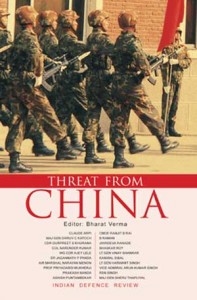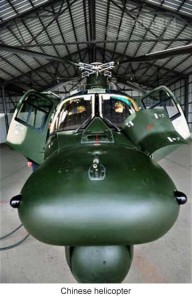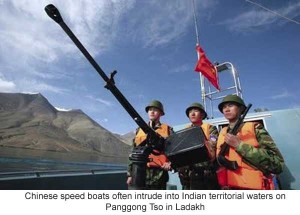The recent denial of a visa by China to one of our senior most serving army officers has taken the Indian Security and Diplomatic establishment by considerable surprise, more so when the visa was being sought for an official visit. The surprise has clear and justifiable reasons to turn into consternation because of a cluster of similar messages conveyed through aggressive statements and actions over the last couple of years. The 6-8 months preceding Beijing Olympics was perhaps the only respite we have had.
Ever since our humiliating defeat of 1962 China has been blowing hot and cold to keep us continually off balance. Till the completion of the Ghormo-Lhasa rail line, the hot and cold was evenly spaced but after that clearly it has been mostly heat that we have felt. The reasons are obvious. Distance to Tibet from mainland China and the existing communications imposed substantial limitations on China’s capacity to control and administer this region. Equally, its ability to maintain, sustain and project military forces from this region were also constrained. The commissioning of the strategic rail line considerably eased the situation and thus also altered the military equation somewhat to Beijing’s advantage.
Click to buy: Threat from China
The rail link connecting mainland China to Tibet has a long history. Since the quelling of the Tibetan uprising in 1959 the necessity to better connect Tibet to Mainland China was unambiguously established. However, because of a host of other priorities like the border issues with the Soviet Union and Viet Nam the decision to execute the project was finally taken in 1994. The stated objective of the rail line was to ‘dismantle the isolation of Tibet ‘and help create an “inseparable organic link’. The concept was also claimed as part of China’s ‘Western development strategy’ (WDS).
The commissioning of the strategic rail line considerably eased the situation and thus also altered the military equation somewhat to Beijings advantage.
The Indian Defense and security establishment has been aware of the project ever since its inception. It has also been conscious of the serious security implications but regrettably other than haplessly observing the progress of the construction and its eventual commissioning in 2006, it has taken no counter measures to neutralize the strategic advantage that China would derive. Concurrent to the building of the rail line the Chinese have been painstakingly augmenting administrative and military capabilities across the Tibetan Plateau. Today China exercises firm control over the Tibetan Autonomous people and has the capacity to swiftly crush all dissent. It has also the capability to project sizeable military forces in both Ladakh and Arunachal Pradesh.
In addition to the rail line, fresh airbases have been developed and their capacities increased. Ever since the activation of the rail line, we have also been witnessing the steady induction of missiles launchers (could be used to deliver either conventional or nuclear warheads) in to the region.
Infrastructure development has kept apace with the flow of military hardware. Images of roads, communication arteries, logistic dumps, barracks downloaded from Google maps reveal the glaring disparity on either side of the divide.
It is not military conventional capability alone that is in China’s favor. Its Second Artillery (nuclear weapons forces) is infinitely superior to ours. Against China we do not even have a credible deterrent capability. Our delivery systems and warheads have limitations and the Chinese know it. They are further comforted by perhaps justifiable assessments that-may be not much is being done to redress this imbalance.
Also read: Chinese incursions and India’s flawed response
Over the last decade China has also been concentrating on building up its blue water navy; the rate at which its submarines and ships are growing is causing alarm not only to us but globally. Japan, Taiwan, South Korea, Viet Nam, the Philippines, Australia and the US are all appearing wary on this count.
“¦for the first time, after centuries, Indias defence has to concentrate itself on two fronts simultaneously.
Further, closer home the collusion with Pakistan to confront us on as many fronts as possible could not be more evident. A similar design can be discerned when Chinese activities are closely scrutinized in Nepal, Myanmar, Bangla Desh and Sri Lanka.
What has been recounted makes a grim picture. And when viewed against the backdrop of the Chinese claims over large tracts of Arunachal Pradesh and the Aksai Chin region we have the serious prospects of a possible war on our hands. There are many arguments against such an eventuality but can we risk a repeat of the humiliation of 1962? And what if the Chinese and Pakistanis work in tandem? There is growing evidence that they are.
Our predicament is evident and can no longer be wished away. So- what next? It would be instructive to return to a letter written by Sardar Patel in Nov 1950 to Nehru our Prime Minister. The abridged letter is reproduced below.
“— I have been anxiously thinking over the problem of Tibet and I thought I should share with you what is passing through my mind.
The Indian Defense and security establishment has been aware of the project ever since its inception. “¦ it has taken no counter measures to neutralize the strategic advantage that China would derive.
—-. The Chinese Government has tried to delude us by professions of peaceful intention. My own feeling is that at a crucial period they managed to instill into our Ambassador a false sense of confidence in their so-called desire to settle the Tibetan problem by peaceful means. There can be no doubt that during the period covered by this correspondence the Chinese must have been concentrating for an onslaught on Tibet. The final action of the Chinese, in my judgment, is little short of perfidy. The tragedy of it is that the Tibetans put faith in us; they chose to be guided by us; and we have been unable to get them out of the meshes of Chinese diplomacy or Chinese malevolence.
Our Ambassador has been at great pains to find an explanation or justification for Chinese policy and actions. As the External Affairs Ministry remarked in one of their telegrams, there was a lack of firmness and unnecessary apology in one or two representations that he made to the Chinese Government on our behalf. — Therefore, if the Chinese put faith in this, they must have distrusted us so completely as to have taken us as tools or stooges of Anglo-American diplomacy or strategy.
This feeling, if genuinely entertained by the Chinese in spite of your direct approaches to them, indicates that even though we regard ourselves as the friends of China, the Chinese do not regard us as their friends. — During the last several months, outside the Russian camp, we have practically been alone in championing the cause of Chinese entry into UN and in securing from the Americans assurances on the question of Formosa. We have done everything we could to assuage Chinese feelings, to allay its apprehensions and to defend its legitimate claims in our discussions and correspondence with America and Britain and in the UN.
Inspite of this, China is not convinced about our disinterestedness; it continues to regard us with suspicion and the whole psychology is one, at least outwardly, of scepticism perhaps mixed with a little hostility.—- Their last telegram to us is an act of gross discourtesy not only in the summary way it disposes of our protest against the entry of Chinese forces into Tibet but also in the wild insinuation that our attitude is determined by foreign influences. It looks as though it is not a friend speaking in that language but a potential enemy.
Also read: China’s Threat Perception
In the background of this, we have to consider what new situation now faces us as a result of the disappearance of Tibet, as we knew it, and the expansion of China almost up to our gates. Throughout history we have seldom been worried about our north-east frontier. The Himalayas have been regarded as an impenetrable barrier against any threat from the north. We had a friendly Tibet which gave us no trouble. — China — is united and strong.
 All along the Himalayas in the north and north-east, we have on our side of the frontier a population ethnologically and culturally not different from Tibetans and Mongoloids. The undefined state of the frontier and the existence on our side of a population with its affinities to the Tibetans or Chinese have all the elements of the potential trouble between China and ourselves. — Chinese ambitions in this respect not only cover the Himalayan slopes on our side but also include the important part of Assam.They have their ambitions in Burma also.—–. While our western and north-western threat to security is still as prominent as before, a new threat has developed from the north and north-east. Thus, for the first time, after centuries, India’s defence has to concentrate itself on two fronts simultaneously. Our defence measures have so far been based on the calculations of superiority over Pakistan. In our calculations we shall now have to reckon with communist China in the north and in the north-east, a communist China which has definite ambitions and aims and which does not, in any way, seem friendly disposed towards us.
All along the Himalayas in the north and north-east, we have on our side of the frontier a population ethnologically and culturally not different from Tibetans and Mongoloids. The undefined state of the frontier and the existence on our side of a population with its affinities to the Tibetans or Chinese have all the elements of the potential trouble between China and ourselves. — Chinese ambitions in this respect not only cover the Himalayan slopes on our side but also include the important part of Assam.They have their ambitions in Burma also.—–. While our western and north-western threat to security is still as prominent as before, a new threat has developed from the north and north-east. Thus, for the first time, after centuries, India’s defence has to concentrate itself on two fronts simultaneously. Our defence measures have so far been based on the calculations of superiority over Pakistan. In our calculations we shall now have to reckon with communist China in the north and in the north-east, a communist China which has definite ambitions and aims and which does not, in any way, seem friendly disposed towards us.
Let us also consider the political conditions on this potentially troublesome frontier. Our northern and north-eastern approaches consist of Nepal, Bhutan, Sikkim, Darjeeling and the tribal areas in Assam. From the point of view of communication, there are weak spots. Continuous defensive lines do not exist. There is almost an unlimited scope for infiltration. —-. The contact of these areas with us is by no means close and intimate. The people inhabiting these portions have no established loyalty or devotion to India.
 —- Nepal has a weak oligarchic regime based almost entirely on force: it is in conflict with a turbulent element of the population as well as with enlightened ideas of the modern age. In these circumstances, to make people alive to the new danger or to make them defensively strong is a very difficult task indeed and that difficulty can be got over only by enlightened firmness, strength and a clear line of policy.—– In my judgment the situation is one which we cannot afford either to be complacent or to be vacillating. We must have a clear idea of what we wish to achieve and also of the methods by which we should achieve it. Any faltering or lack of decisiveness in formulating our objectives or in pursuing our policies to attain those objectives is bound to weaken us and increase the threats which are so evident.
—- Nepal has a weak oligarchic regime based almost entirely on force: it is in conflict with a turbulent element of the population as well as with enlightened ideas of the modern age. In these circumstances, to make people alive to the new danger or to make them defensively strong is a very difficult task indeed and that difficulty can be got over only by enlightened firmness, strength and a clear line of policy.—– In my judgment the situation is one which we cannot afford either to be complacent or to be vacillating. We must have a clear idea of what we wish to achieve and also of the methods by which we should achieve it. Any faltering or lack of decisiveness in formulating our objectives or in pursuing our policies to attain those objectives is bound to weaken us and increase the threats which are so evident.—- The whole situation thus raises a number of problems on which we must come to an early decision so that we can, as I said earlier, formulate the objectives of our policy and decide the method by which those objectives are to be attained. It is also clear that the action will have to be fairly comprehensive, involving not only our defence strategy and state of preparations but also problem of internal security to deal with which we have not a moment to lose. We shall also have to deal with administrative and political problems in the weak spots along the frontier to which I have already referred.
It is of course, impossible to be exhaustive in setting out all these problems. I am, however, giving below some of the problems which, in my opinion, require early solution and round which we have to build our administrative or military policies and measures to implement them.
- A military and intelligence appreciation of the Chinese threat to India both on the frontier and to internal security.
- An examination of military position and such redisposition of our forces as might be necessary, particularly with the idea of guarding important routes or areas which are likely to be the subject of dispute.
- An appraisement of the strength of our forces and, if necessary, reconsideration of our retrenchment plans for the Army in the light of the new threat.
- A long-term consideration of our defence needs. My own feeling is that, unless we assure our supplies of arms, ammunition and armour, we would be making our defence perpetually weak and we would not be able to stand up to the double threat of difficulties both from the west and north-west and north and north-east.
- The political and administrative steps which we should take to strengthen our northern and north-eastern frontier.
- Improvement of our communication, road, rail, air and wireless, in these areas and with the frontier outposts.
- The policy in regard to the McMahon Line.—”
What is indeed remarkable is that the contents of this letter have not lost their relevance even today. The analysis was cogent and the recommendations astutely formulated. Sadly they were not acted upon. What is even more noteworthy is the enduring wisdom the letter contains. Ironically most of the recommendations remain valid even today.
Our response to the potential threat from China has to be multi dimensional with the military being given overriding importance. If we are militarily inadequately manned armed and equipped the undergirding to our security will inevitably be extremely fragile”¦
The other comment that can be made with some justification is that our political leadership for most of our independent history seems to have been bereft of pragmatism and a resolve to do whatever is necessary to secure and advance our national strategic interests. The frequently offered argument in defense of the establishment –that India is an extremely complex country to govern is not a good enough excuse for the drift that we have witnessed in the context of the numerous security concerns that have bedeviled us over the last six decades.
Our response to the potential threat from China has to be multi dimensional with the military being given overriding importance. If we are militarily inadequately manned armed and equipped the undergirding to our security will inevitably be extremely fragile; there is only so much that diplomacy and dialogue can achieve. Alignments, cooperative arrangements, economic engagement have their role to play and must form part of the comprehensive strategy that we pursue. But these will gather adequate traction only if our defense apparatus poses a credible deterrence.
Our military machine has perennially faced a few problems. The first and perhaps the most important is the poor communication between the political leaders and the military. The political leadership is comfortable with the bureaucracy and prefers to deal with the defense officers through them. Unless this changes our defense capability will never be optimized. Both the political leadership and the military must introspect in this matter.
The second is the inadequacy of the defense budget. Given India’s security environment an allocation of barely two percent of the GDP is wholly inadequate. The Nation, given our circumstances, can afford 3 percent without seriously compromising on our developmental goals. The answer rather lies in the better management of the funds allocated for development and not curtailment of the defense budget..
The third requirement is the commitment of funds for the modernization of the defense forces based on a long term perspective. Fitting the services long term plans into each year’s budget allocation has not worked. Service Chiefs have repeatedly emphasized this point but to no avail.
The third is the sloppy and inefficient way of spending the allotted funds. For decades the MOD and the services have been throwing stones at each other on the subject and scarce money continues to be poorly spent. Unfortunately our defense ministers have done little to solve this problem. A related issue is the system of procurement. Whatever system we create and we have tried many- nothing seems to work.
 Lastly is the inescapable- frequently emphasized- imperative of a domestic defense industry that can meet most of the modernization requirements of the defense forces. In 2001 the then Defense Minister- George Fernandes- had announced the policy of opening up the defense sector to the private industry as also permitting up to 26 % FDI but regrettably entrenched interests have ensured business as usual.
Lastly is the inescapable- frequently emphasized- imperative of a domestic defense industry that can meet most of the modernization requirements of the defense forces. In 2001 the then Defense Minister- George Fernandes- had announced the policy of opening up the defense sector to the private industry as also permitting up to 26 % FDI but regrettably entrenched interests have ensured business as usual.
Reports indicate that the armed Forces have shifted focus from the North West to the North and North East. Appropriate structural changes are under consideration. With time, resources and some dedicated effort conventional force equilibrium will be achieved, however the problem of nuclear asymmetry will remain. While on this subject we may recall Mr. George Fernandes’s statement immediately after our nuclear test in 1999 that China is our enemy number one. The context of the statement in the intervening years seems to have been lost sight of. This is a very serious handicap and some solution must be found.
Thus concurrent to the mission of upgrading defense capability the more complex issue of balancing the nuclear equation will prove to be a monumental challenge. But this problem cannot be wished away and has to be addressed head on with the utmost priority. Without a credible nuclear deterrent against China we will continue to be vulnerable to pressures and the bullying that we are frequently being subjected to.
In seeking a solution to our territorial issues we must understand that possibly the route to solving our boundaries with Pakistan may lie via Beijing but trying to deal with China through Pakistan will not work. We must therefore be clear about our priority.
 In conclusion- notwithstanding the precautions we may be taking we have to engage China in a spirit of cooperation and friendship. If both our nations work in concert and have a complementary approach to global issues we can both prosper and develop. There is enough space for the two of us to transform the 21 century into an Asian Century. In any case the two most ancient civilizations of the world should be doing better than exchanging insults not forgetting that the World is watching.
In conclusion- notwithstanding the precautions we may be taking we have to engage China in a spirit of cooperation and friendship. If both our nations work in concert and have a complementary approach to global issues we can both prosper and develop. There is enough space for the two of us to transform the 21 century into an Asian Century. In any case the two most ancient civilizations of the world should be doing better than exchanging insults not forgetting that the World is watching.




